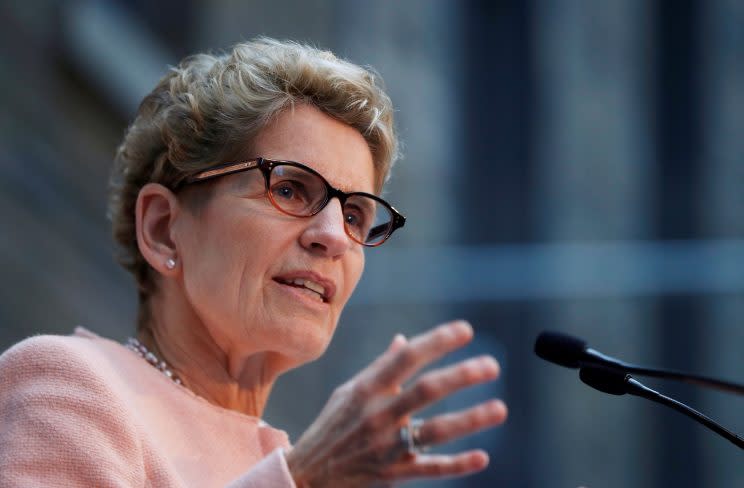Is $17,000 a good enough starting point for basic income?

The majority of Canadians support Ontario’s basic income program but four in ten question whether the magic number – $17,000 – is enough.
An online survey of around 2,000 Canadians by Campaign Research found that 53 per cent approve of Ontario’s basic income pilot, which will support a select 4,000 low-income earners in Hamilton, Thunder Bay and Lindsay with up to $16,989 per year and $24,027 for a couple (less 50 per cent of any earned income) in a bid to pin down the effects it can have on job prospects and quality of life. There will be an additional $6,000 per year for individuals with disabilities.
Of the basic income pilot supporters, eight per cent say they think the yearly income of $17,000 is too much, 48 per cent say it’s “about the right amount” and 39 per cent say it is too little.
Sheila Regehr, chair of non-profit Basic Income Canada Network and a participant in the consultations surrounding the pilot, says the debate is central to the experiment in general.
“The fact that it’s stimulated a lot of conversation is one of the most important things about the pilot,” she says. “This is a really different way of thinking about how we are distributing resources to people.”
As part of the program, recipients can keep any child benefits, disability, dental and pharmaceutical access they are already entitled to, but participants receiving Employment Insurance (EI) or Canada Pension Plan (CPP) will have their monthly basic income payment reduced dollar-for-dollar.
According to the province, the $17,000 figure, 75 per cent of the Low Income Measure, was put forth at the advice of Hugh Segal, a former senator, political strategist and longtime proponent of basic income, on the grounds that when “other broadly available tax credits and benefits, would provide an income that will meet household costs and average health-related spending.”
In an op-ed for the National Post, Segal applauded the program saying Canada’s existing welfare programs are “far too limited.”
“In Ontario, for example, a single adult receives payouts equal to about 45 percent of the poverty line, or approximately $9,000,” he wrote. “Existing programs also include dehumanizing micro-eligibility requirements that dilute self-respect, discourage work, and frustrate hardworking caseworkers – they trap people in poverty rather than providing them with a bridge to the economic mainstream.”
Regehr echoes Segal, saying that in her discussions with Ontario officials during the consultations, they said they suspect “many people will actually get to or very close to 100 per cent” when other types of support are taken into account.
“I think it is pretty reasonable especially when you compare it to social assistance rates for single people which are abysmal and a complete lack of social protection for people trying to eke out a living with two or three low-income jobs,” says Regehr.
But David Wakely, senior partner at management labour and employment law firm, Filion, Wakely, Thorup, Angeletti LLP – which works with both public and private sector employers – says he isn’t convinced the program is a good idea.
“We’ve got the Manitoba situation and the US experiment and some in Europe but I think a very hard look at the little bit of data we have leads to certain conclusions that I don’t think are ambiguous,” says Wakely. “The disincentive to work has been established and borne out by the experiments.”
He says he’s concerned employers haven’t “turned their minds” to the potential effects of a $17,000 basic income guarantee.
“The studies in Manitoba, the U.S. – Denver – suggest the higher you peg the basic income guarantee, the more the deleterious effect and the more the negative impacts are in terms of offering a disincentive to work,” he says pointing that employers will have to raise wages in order to attract candidates who are already receiving a basic income.
“It’s obvious over the last 20 years, (driving) wages up forces employers to outsource, subcontract, go to automation… various factors to try and remain competitive,” he says. “I think that’s an unintended consequence.”
While the provincial government has committed $1.5 billion to the three-year experiment, Wakely points out that eventually, if it’s taken on, it’s going to need to be subsidized likely by higher taxes on corporations or upper-bracket earners.
“I think is going to have a very harmful effect on the economy in general,” he says, adding that he’s not convinced it’s “going to get off the ground.”
“It hasn’t gotten off the ground in any place it’s been experimented with, it’s just human nature for the payers to say ‘why would I do this, why would I prepared to underwrite this so someone else can make $17,000 for doing nothing?’ ” says Wakely. “And where people start to perceive the tax system as being unfair it justifies the human instinct to try and beat the system… it’ll turn into Greece – that’s what I would fear.”
Regehr, on the other hand, is optimistic, saying that the pilot will give us a new angle on the ripple effects of a basic income program.
“For me and for people in this movement, there’s no question that this is the way we have to go in this modern society,” she says. “We have to… the sooner we do it, the sooner we figure out how to do it the better.”

 Yahoo Finance
Yahoo Finance 